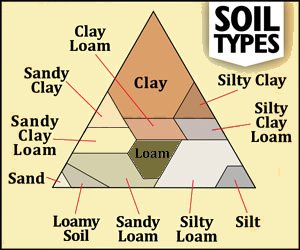Soil Types
 |
Knowing what soil you have is the starting point of knowing how much water your lawn will need and how well it will grow. So before moving forward, a soil test is always a good starting point. We can perform a soil test for you, but we do not sell soil testing kits as the results always need analysing by a professional. A basic soil test starts with measuring the soil pH followed by a soil composition test. pH is a measurement scale by which you can gauge the level of acidity or alkalinity in your soil. It ranges from 0 to 14. Above 7.0 is alkaline and below 7.0 is acidic. A soil pH of 6.0 to 7.5 is ideal for lawns. After the pH test, a composition test will tell you whether the soil is right for growing, retaining water etc. |

|
The European soil classification system divides soil into 23 different types. Many of these are widely distributed throughout the continent, but there are also several that are present almost exclusively in certain small regions. A disproportionate number of these can be found in Spain, which on the whole has very different soil from the rest of Europe.
Acrisols
In Europe, acrisols are present only in Spain, Turkey and Romania. They are low in nutrients and contain accumulations of clay. These soils are also very susceptible to erosion and contain high amounts of aluminum. They occur primarily in the Southwestern region of Spain and are not usually suitable for agriculture.
Calcisols
Calcisols are the most common soils in Spain. As indicated by the name of the order, these soils are high in calcium, specifically in the form calcium carbonate. The source of this mineral can be layers of lime or root nodules. They are highly alkaline and form in locations with distinctly differentiated dry seasons. They are often found in areas where groundwater rich in lime rises to the surface, leaving behind mineral deposits.
Fluvisols
These soils are present in areas with frequent flooding. As such, they contain soil deposits from rivers and bodies of water. Some are fertile, but others are not; fertility depends on the frequency of flooding and the type of soil deposited. They are scattered widely throughout Spain, but are most concentrated in the North Central area of the country.
Leptosols
These gravelly soils develop over hard rock in areas of high erosion. They can be found on mountains and in areas where rocks are close to the surface. Leptosols are dominant in many areas along Spain's Northern and Eastern borders. They are some of the most common soils in the world.
Luvisols
Luvisols have high amounts of clay in the subsoil and low amounts in the surface soil. This is a diverse order and can occur in many different environments, but soils of this type generally occur in well-drained areas. They are scattered throughout Spain.
Regosols
Regosols are very common in Spain, especially in the West. These soils are young and undeveloped, occurring primarily in mountainous, arid or rapidly eroding areas. Often development is prevented by inadequate temperatures or moisture. Generally soils that cannot be placed into any other category are designated as Regosols.
Umbrisols
Umbrisols are dominant in the region north of Portugal. They are rich in organic materials and usually form underneath forests. They occur in climates that are humid and cool. These acid soils are dark in appearance and cover only a small part of Europe, despite their strong presence in Spain.
Details on how to correct soil pH imbalance are in our Customised
Lawn Repair Project.![]()


